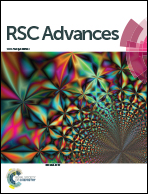Colorimetry and phase transition characteristics in sensing fluoride anion based on hydrazide organogelators†
Abstract
The fluoride anion sensing properties of BNB-t4 and BNBC-t8 consisting of hydrazide and azobenzene moieties both in solution and gel state, and the involved binding mechanism have been systematically investigated in this work. The remarkable changes in the absorption of receptor BNB-t4 with a terminal hydroxyl group demonstrate a colorimetric chemosensor with a higher sensitivity in sensing fluoride anions than that of BNBC-t8 with a terminal methoxy group. The detection limit of BNB-t4 for the analysis of F− can reach as low as 4.27 × 10−8 M, while this value is 2.02 × 10−6 M for BNBC-t8. The results indicate that the F− ion interacts with the amidic –NH and hydroxyl proton of BNB-t4 via hydrogen-bonding to give the stable 1 : 2 complex at the first equilibrium state, and further addition of F− can induce deprotonation by forming HF2− to establish a second equilibrium state. Meanwhile, the gel–sol transition of BNB-t4 has been successfully applied in sensing fluoride anions and thus makes BNB-t4 a naked-eye sensor. The color change of BNB-t4 induced by binding fluoride anions can be safely switched off with the addition of HSO4−, demonstrating an OFF–ON–OFF colorimetric sensor with a good reversibility.



 Please wait while we load your content...
Please wait while we load your content...